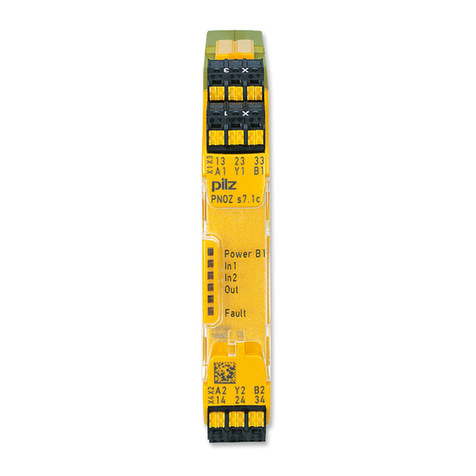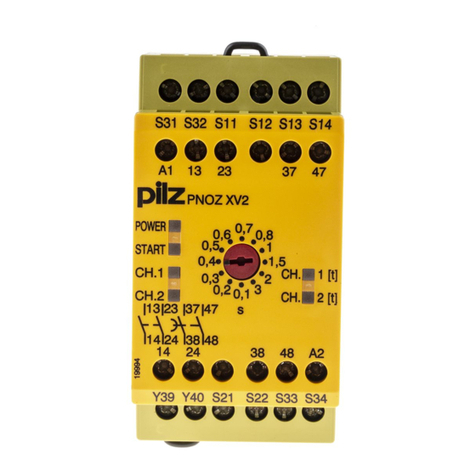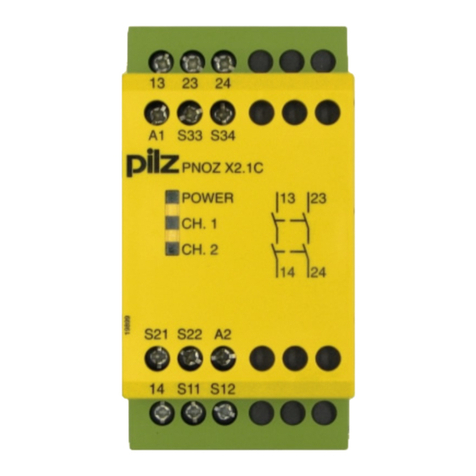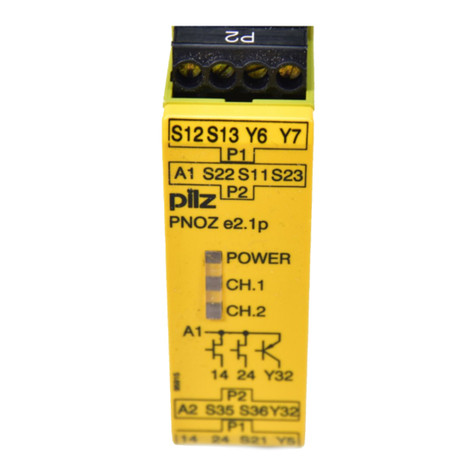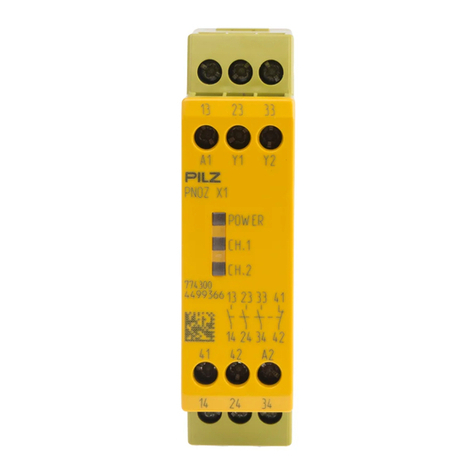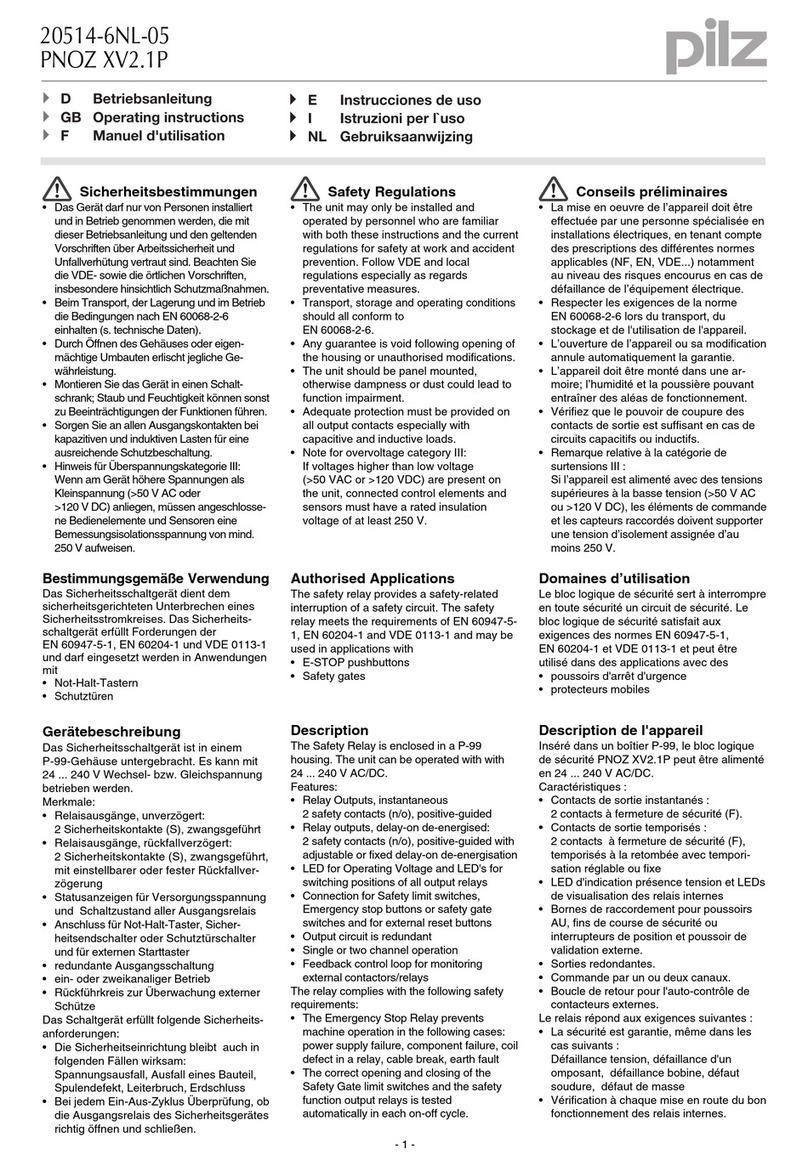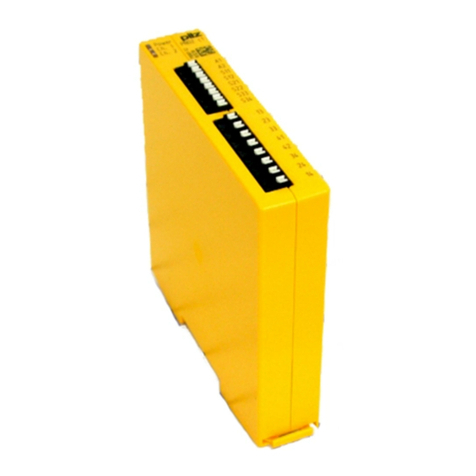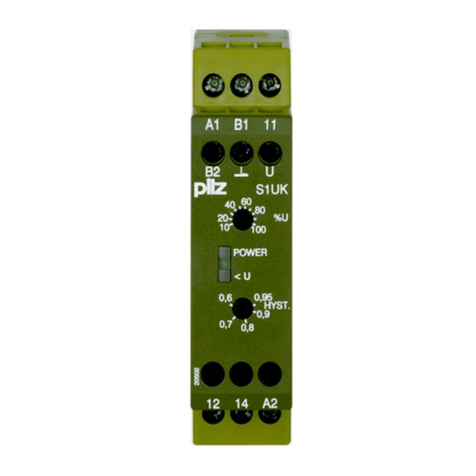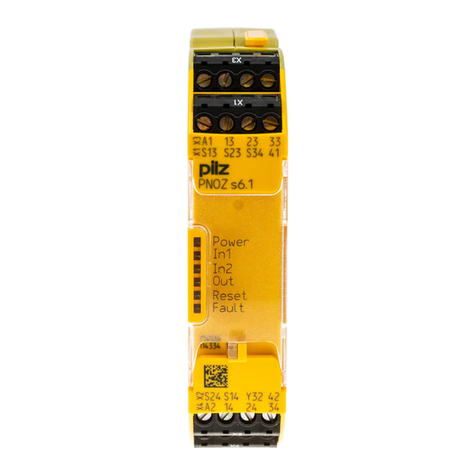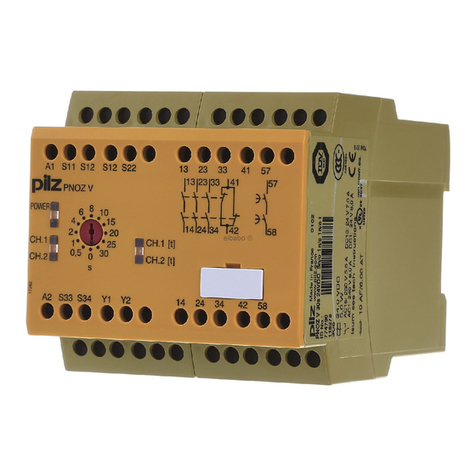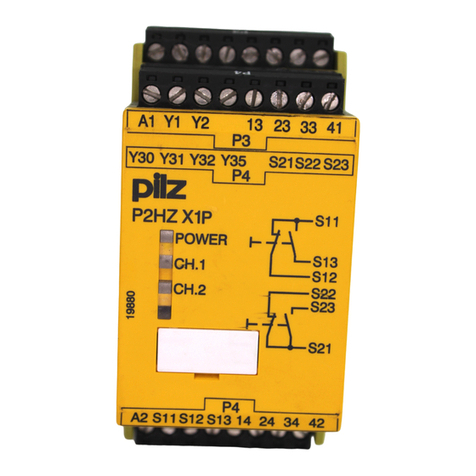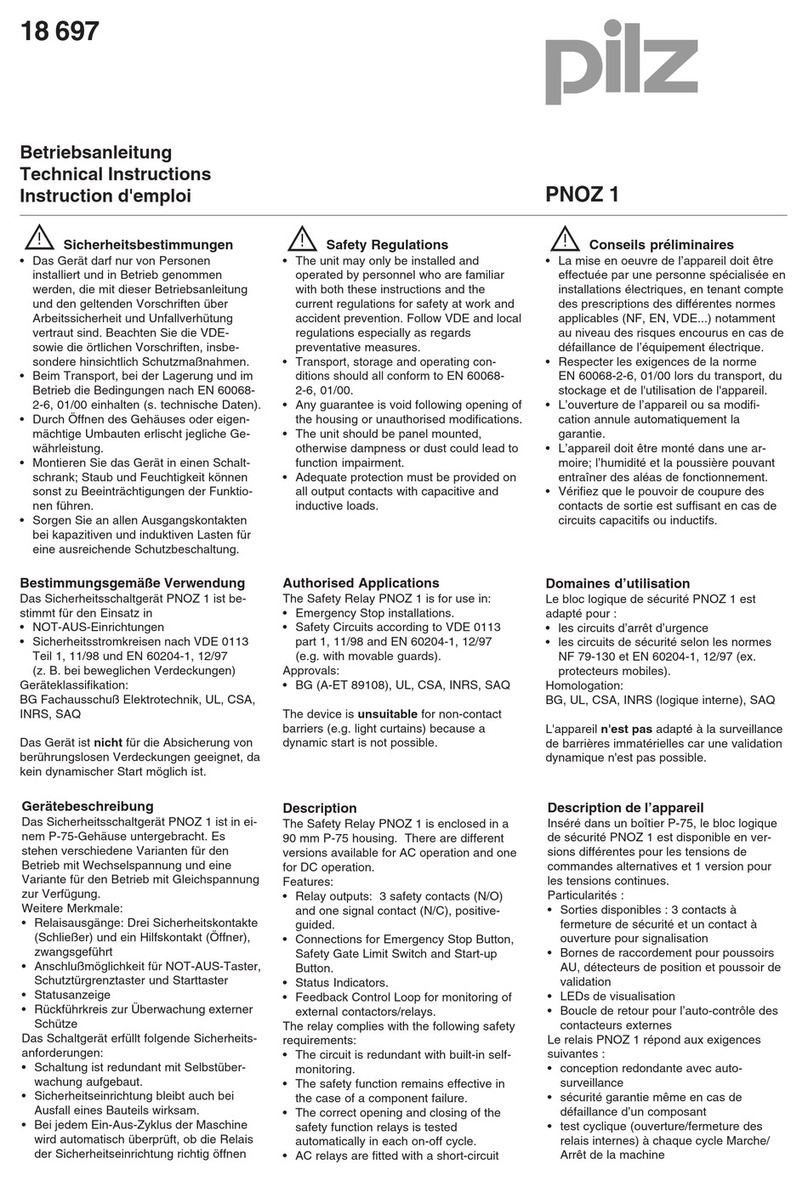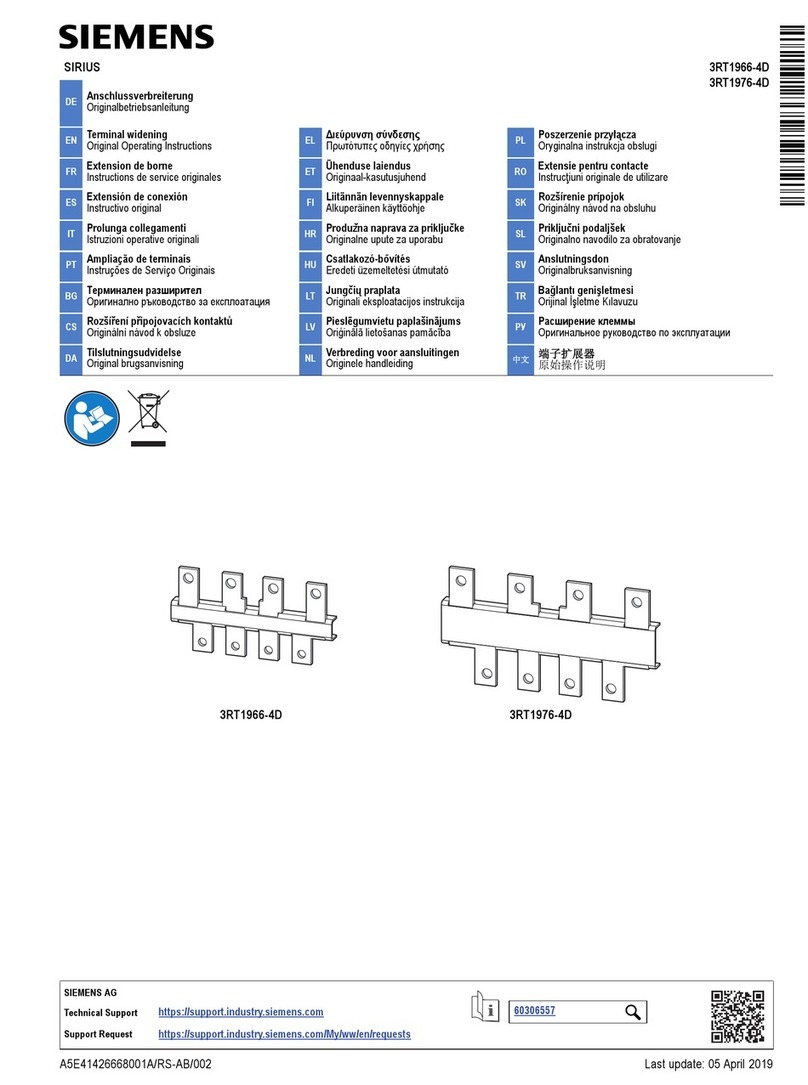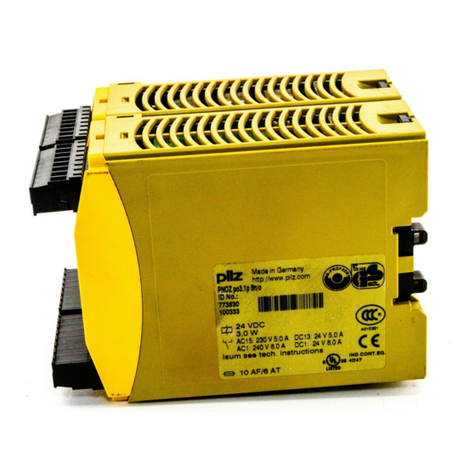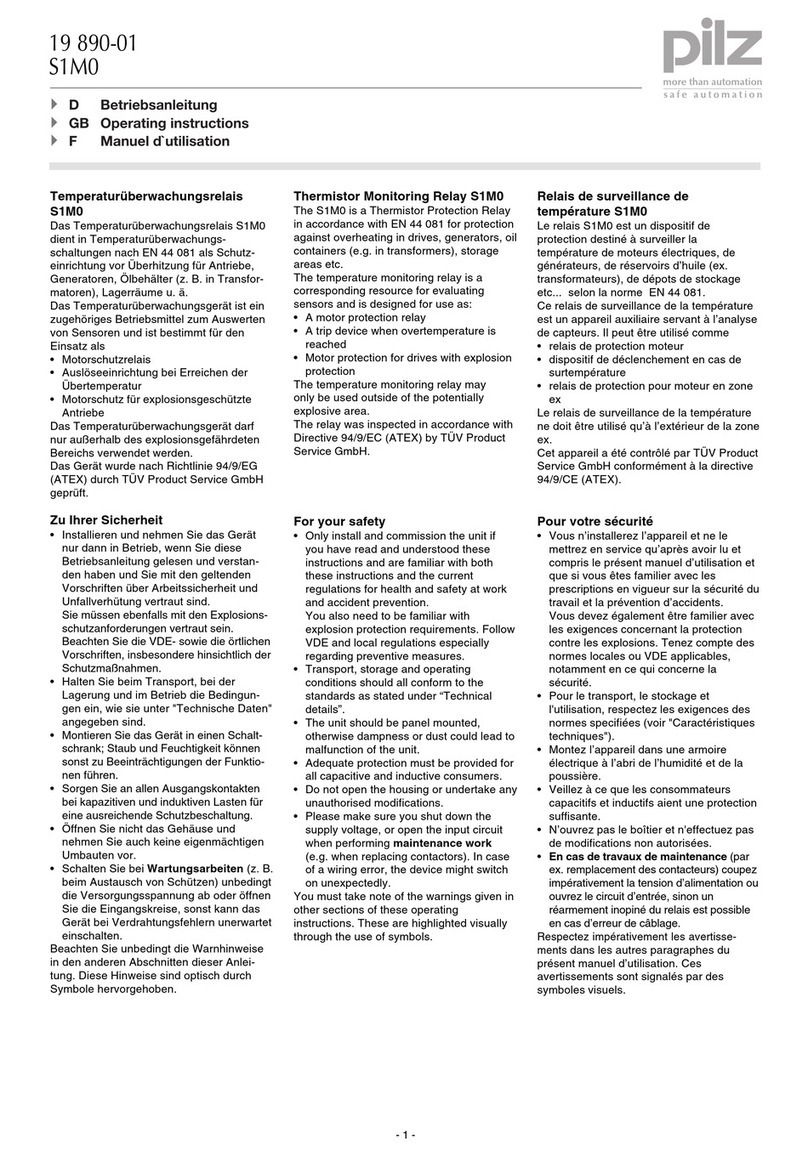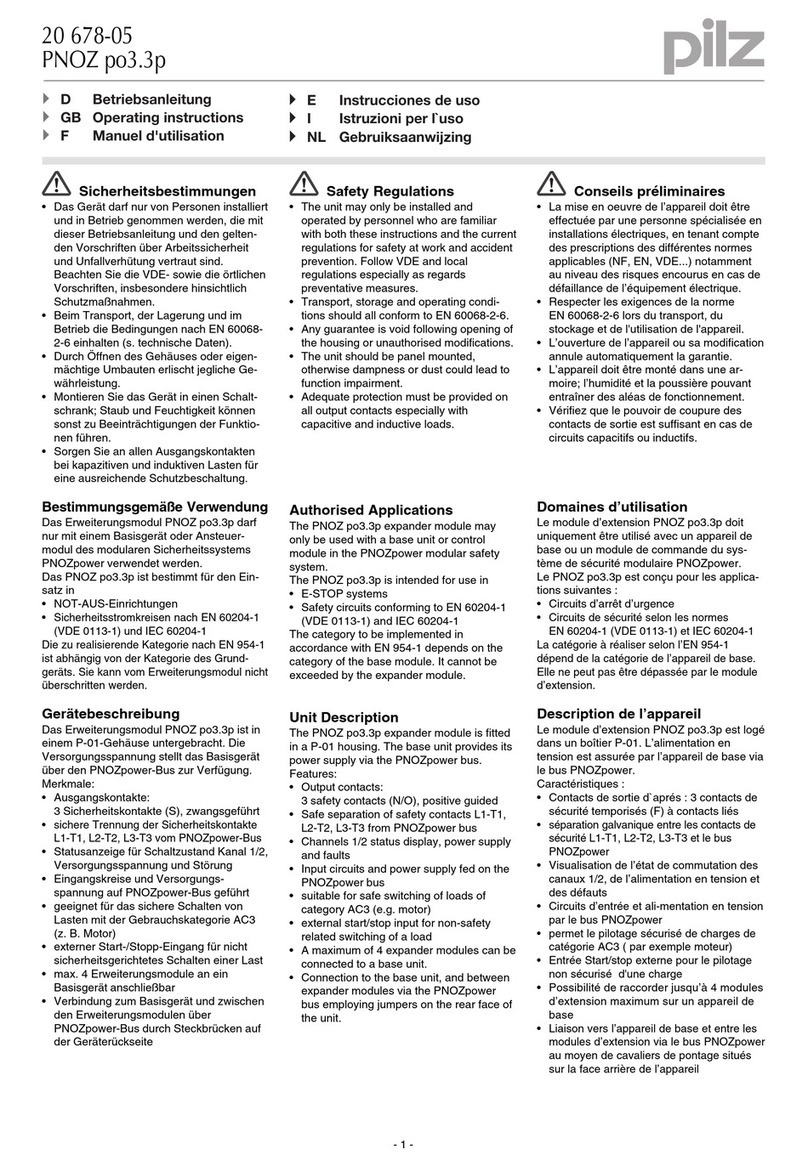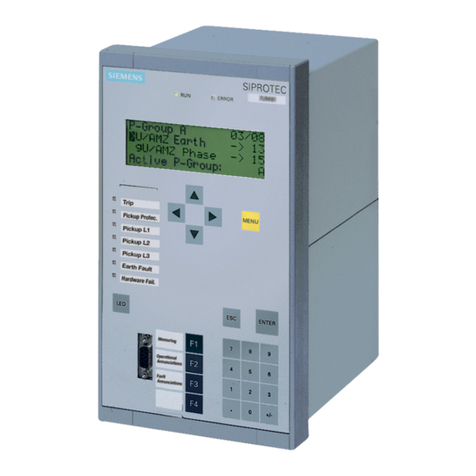
- 2 -
Gerätebeschreibung
Sicherheitseigenschaften
Das Schaltgerät erfüllt folgende Sicher-
heitsanforderungen:
• Das Sicherheitssystem erfüllt bezüglich
eines Fehlerfalls die Anforderungsklasse
AK6 nach DIN VDE 0801 (Kategorie 4
nach EN 954-1). Die Schaltmatte erfüllt
diese Anforderung nur bedingt (siehe
Abschnitt 4.15 der DIN EN 1760-1).
• Die Schaltung ist redundant mit Selbst-
überwachung aufgebaut.
• Die Sicherheitseinrichtung bleibt auch bei
Ausfall eines Bauteils wirksam.
• Die Sicherheitsausgänge werden durch
einen Abschalttest periodisch geprüft.
• Das Gerät besitzt eine elektronische
Sicherung.
Gerätemerkmale
• Ausgänge in Halbleitertechnik:
2 Sicherheitsausgänge, wahlweise
unverzögert oder verzögert, 1 Hilfsaus-
gang und 2 Taktausgänge
• Anschlussmöglichkeit für Schaltmatten
vom Typ SM/BK der Fa. Mayser
• Rückfallverzögerung einstellbar
• Hilfsausgang umschaltbar als Diagnose-
ausgang
• UND- und ODER-Eingang zur logischen
Verknüpfung mehrerer Geräte
• Querschlussüberwachung durch Takt-
ausgänge
• Statusanzeige
• Rückführkreise zur Überwachung
externer Schütze
Unit description
Safety features
The relay meets the following safety
requirements:
• In the case of an error, the safety system
complies with requirement class AK6 as per
DIN VDE 0801 (category 4 as per
EN 954-1). The safety mat meets this
requirement only under certain conditions
(see section 4.15 of DIN EN 1760-1).
• The circuit is redundant with built-in self-
monitoring.
• The safety function remains effective
even in the case of a component failure.
• The safety outputs are tested periodically
using a disconnection test.
• The unit has an electronic fuse.
Unit features
• Outputs using semiconductor technology:
2 safety outputs,instantaneous or
delayed (optional), 1 auxiliary output and
2 test pulse outputs
• Ability to connect Mayser SM/BK type
safety mats
• Delay-on de-energisation can be selected
• Auxiliary output can be used as a
diagnostic output
• AND/OR input for logic connections
between several units
• Test pulse outputs monitor shorts across
the input contacts
• Status display
• Feedback loops for monitoring external
contactors
Description de l’appareil
Propriétés de sécurité
Le bloc logique satisfait aux exigences de
sécurité suivantes :
• Le système de sécurité répond à la classe
d’exigence AK6 de la norme
DIN VDE 0801 (Catégorie 4 selon EN 954-
1)
pour ce qui concerne un cas d’erreur.
Le tapis sensible ne répond que sous
condition à ces exigences (voir section
4.15 de la norme DIN EN 1760-1).
• La conception du circuit est redondante
avec autosurveilance.
• Le dispositif de sécurité reste actif, même
en cas de défaillance d’un composant.
• Les sorties de sécurité sont testées
périodiquement à l’aide d’un test de
coupure.
• L’appareil est équipé d’un fusible
électronique.
Caractéristiques de l’appareil
• Sorties statiques : 2 sorties de sécurité,
au choix instantanées ou temporisées,
1 sortie d’information et 2 sorties
impulsionnelles
• Possibilité de raccordement des tapis
sensibles de type SM/BK de la société.
Mayser
• Retard à la retombée réglable
• Sortie d’information commutable en sortie
de diagnostic
• Entrées ET et OU pour le couplage
logique de plusieurs appareils
• Surveillance des courts-circuits par
sorties impulsionnelles
• Affichage de l’état
• Boucle de retour pour le contrôle des
contacteurs externes
Descriptif du fonctionnement
Fonctionnement
Deux microcontrôleurs analysent les circuits
d’entrée et commutent les sorties en
conséquence. Les microcontrôleurs se
contrôlent mutuellement.
État des sorties
• Ne pas marcher sur le tapis sensible :
Les sorties de sécurité 14 et 24
(retardées à la retombée) et la sortie
d’information Y32 présentent des signaux
Haut.
• Marcher sur le tapis sensible :
Les sorties de sécurité 14 et 24
(retardées à la retombée) et la sortie
d’information Y32 présentent des signaux
Bas.
Fonctions
• Si un signal Haut (+24 V CC) est appliqué
sur l’entrée Y5 pendant au moins 250 ms,
la sortie Y32 commute en sortie diagnos-
tic. La commande s’effectue par le biais
d’un protocole, disponible en tant qu’acces-
soire ou programmable par l'utilisateur. Si
l’entrée Y5 est ouverte ou en niveau Bas,
Y32 fonctionne comme une sortie d’infor-
mation.
• Pour le couplage logique de plusieurs
appareils, le PNOZ e4vp possède une
entrée ET et une entrée OU. Les entrées
sont temporisées. Si plusieurs appareils
sont couplés en ET logique, les durées de
temporisations se cumulent
• La sortie de sécurité 24 est retardée à
la retombée. La durée de retard est
réglable
• En cas de défaut, une diminution de la
temporisation à la retombée est possible.
Function description
Operation
Two microcontrollers evaluate the input
circuits and switch the outputs accordingly.
The microcontrollers monitor each other.
Output status
• Safety mat not activated:
High signals at safety outputs 14 and 24
(delay-on de-energisation) and auxiliary
output Y32.
• Safety mat activated:
Low signals at safety outputs 14 and 24
(delay-on de-energisation) and auxiliary
output Y32.
Functions
• If there is a high signal (+24 V DC) at
input Y5 for at least 250 ms, output Y32
switches to diagnostic mode. It is
controlled via a driver that is available as
an accessory or that you can create
yourself. If input Y5 is open or low, Y32
will operate as an auxiliary output.
• For logic connections between several
units, the PNOZ e4vp has one AND and
one OR input. The inputs have switch
delays. If several devices are AND-
connected, these delay times are added
together.
•Safety output 24 has delay-on de-
energisation. The release time can be
selected.
• Delay-on de-energisation can be reduced
in the event of a fault.
Funktionsbeschreibung
Arbeitsweise
Zwei Mikro-Controller werten die Eingangs-
kreise aus und schalten abhängig davon die
Ausgänge. Die Mikro-Controller überwachen
sich gegenseitig.
Zustand der Ausgänge
• Schaltmatte nicht betreten:
An den Sicherheitsausgängen 14 und 24
(rückfallverzögert) und dem Hilfsausgang
Y32 liegen High-Signale.
• Schaltmatte betreten:
An den Sicherheitsausgängen 14 und 24
(rückfallverzögert) und dem Hilfsausgang
Y32 liegen Low-Signale.
Funktionen
• Wenn an den Eingang Y5 für mindestens
250 ms ein High-Signal (+24 V DC) gelegt
wird, wechselt der Ausgang Y32 in die
Diagnosefunktion. Die Ansteuerung
erfolgt über einen Treiber, der als
Zubehör zur Verfügung steht oder selbst
erstellt werden kann. Ist der Eingang Y5
offen oder Low, funktioniert Y32 wie ein
Hilfsausgang.
• Zur logischen Verknüpfung mehrerer
Geräte besitzt das PNOZ e4vp einen
UND- und einen ODER-Eingang. Die
Eingänge weisen Schaltverzögerungen
auf. Werden mehrere Geräte UND-
verknüpft, addieren sich diese
Verzögerungszeiten.
• Der Sicherheitsausgang 24 ist rück-
fallverzögert. Die Rückfallzeit ist
einstellbar.
• Im Fehlerfall kann sich die Rückfall-
verzögerung verkürzen.


